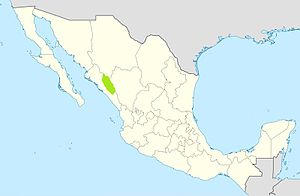Acaxee Rebellion
| Acaxee Rebellion | |||||||
|---|---|---|---|---|---|---|---|
| Part of the Mexican Indian Wars | |||||||
 A map of Mexico showing the location of the Acaxee in Sinaloa and Durango states. | |||||||
| |||||||
| Belligerents | |||||||
| Spaniards |
Tepehuanos Xiximes | ||||||
The Acaxee Rebellion was an insurrection against
The Acaxee
The Acaxee spoke a
the cultivation of corn, beans, squash, chilies, and cotton adjacent to small villages and settlements…; frequent warfare with associated ritual cannibalism; polytheism and worship of idols; the presences of shamans or ritual specialists…; and a decentralized political structure that relied on the leadership of elders in peacetime and on war leaders to deal with outsiders.[2]
The dispersed village culture of the Acaxee at the time of the first Spanish contact in the late 16th century may have been the remnant of a more complex hierarchical society that had been decimated by disease earlier in the same century.
The Spaniards
The Spanish discovered silver deposits in Acaxee territory in the 1580s and established several mining camps. Several hundred Spaniards, African and Indian slaves, and Indian laborers migrated into the Acaxee country. They needed additional labor to work in the mines. Through the encomienda system the Indians were forced to work in Spanish mines. However, the dispersed nature of the Acaxee settlements was a hindrance to utilizing Indian labor.[5]
The rebellion
An Indian leader named Perico initiated the rebellion in late 1601. Using a mixture of Spanish and Indian religious practices, he promised his followers that the Spanish could be exterminated. The rebellion "was characterized by messianic leadership and promises of millennial redemption during a period of violent disruption and catastrophic demographic decline due to disease." The rebellion aimed "to restore pre-Columbian social and religious elements that had been destroyed by the Spanish conquest."[7]
Indian attacks over the first few weeks killed about 50 Spaniards. The Acaxee burned Spanish mining camps and buildings, including 40 churches, and besieged 40 Spanish in a church at San Andres. The siege was raised when reinforcements arrived from Durango. The priest Santarén led a peace delegation but several members of his group were killed as were members of another delegation led by a bishop.[8]
The Acaxee took up strong positions in the mountains and shut down most silver mining and other economic activities in their homeland for nearly two years. In 1603, the Spaniards gathered an army of
In the aftermath of the war the Jesuits assumed even greater influence, consolidating the Acaxee into a few settlements, appointing their leaders, and attempting to educate Indian children and remove them from the influence of their parents. In 1607, a smallpox epidemic combined with the simultaneous appearance of Halley's Comet, a portent of disaster, seems to have erased most remaining traces of the Acaxee's independence, although a few joined the Tepehuán Revolt in 1616.[10][11]
References
- ^ Deeds, Susan M. Defiance and Deference in Mexico's Colonial North. Austin: U of TX Press, 2003, p 14
- ^ Schroeder, Susan. Native Resistance and the Pax Colonial in New Spain. Lincoln: U of Neb Press, 1998, p. 4
- ^ Schroeder, p. 4
- ^ Deeds, p. 16
- ^ Deeds, p. 21
- ^ Deeds, pp.21-22
- ^ Susan M. Deeds, quoted from Schmal, John P. "The History of Indigenous Durango." http://www.houstonculture.org/mexico/durango.html, accessed 27 Jan 2011
- ^ Bancroft, Hubert Howe. History of the North Mexico States, Vol 1, 1531-1800, San Francisco: Bancroft & Co.,1884, p. 314-315
- ^ Deeds, p. 24
- ^ Deeds, p. 25
- ^ Gradie, Charlotte M. The Tepehuan Revolt of 1616. Salt Lake City: U of UT Press, 2000, pp 160-161
Further reading
- Deeds, Susan. Defiance and Deference in Mexico's Colonial North: Indians Under Spanish Rule in Nueva Vizcaya. (2003) University of Texas Press, Austin, TX. ISBN 0-292-70551-4
